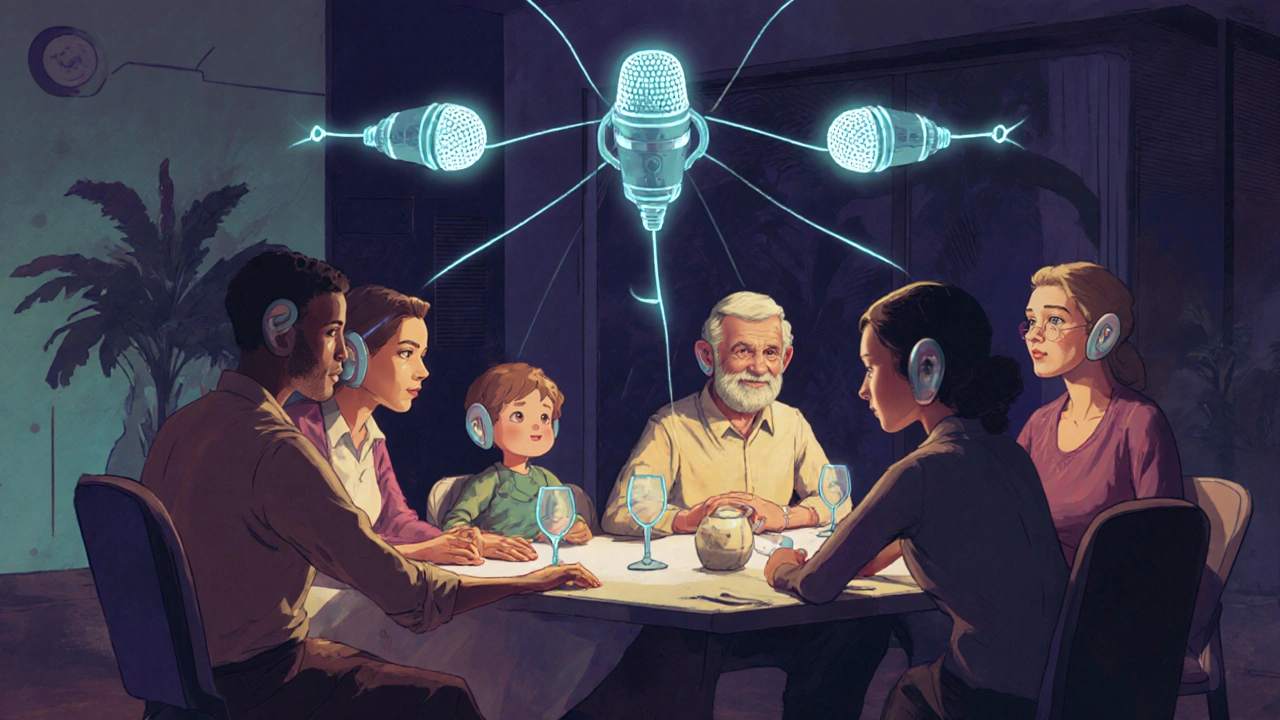
Imagine sitting at a busy restaurant with friends. Laughter, clinking glasses, and overlapping conversations fill the air. You’re wearing your hearing aids, but you still miss half of what’s being said. You nod along, pretending to follow along, but inside, you’re exhausted. This isn’t just frustrating-it’s isolating. For people with hearing loss, noisy environments aren’t just challenging-they’re barriers to connection. That’s where remote microphone systems come in.
What Exactly Is a Remote Microphone System?
A remote microphone system is a small device that picks up speech close to the speaker’s mouth and sends it directly to your hearing aids or cochlear implants. It’s not a speaker. It’s not a headset. It’s a wireless microphone, usually worn by the person talking, that cuts through background noise and delivers clear speech straight to your ears. These systems work by placing a tiny microphone-about the size of a thumb-6 to 8 inches from the speaker’s mouth. That’s close enough to capture speech clearly before it gets drowned out by noise. The signal is then sent via 2.4 GHz radio frequency to a receiver connected to your hearing device. Modern versions like Phonak’s Roger Focus II or ReSound Multi Mic use digital modulation, which means they’re smarter, more reliable, and less prone to interference than old FM systems from the 1990s. Unlike hearing aids alone, which try to amplify everything-including background noise-these systems isolate the voice you want to hear. Studies show they can improve speech understanding in noise by up to 61% compared to hearing aids by themselves. That’s not a small boost. It’s life-changing.Why Distance Kills Speech in Noise
Here’s the simple physics behind why hearing in noise is so hard: every time you double the distance from a speaker, the sound level drops by 6 decibels. So if someone is talking to you from 3 feet away, the sound is already 6 dB quieter than if they were right next to you. At 6 feet? Another 6 dB down. At 12 feet? That’s 18 dB quieter. In a restaurant with 70 dB of background noise, that’s a recipe for missing words. Hearing aids have noise-reduction algorithms and directional microphones, but they’re still limited. They can’t magically pull speech from across the table. That’s where remote microphones step in. By bringing the speaker’s voice to you at near-field distance-even if they’re sitting 10 feet away-you’re essentially resetting the acoustic rules. You’re not hearing them from across the room. You’re hearing them as if they’re right beside you.How Modern Systems Beat the Old Ones
Older FM systems, used in schools since the 1970s, worked on fixed radio frequencies. They were prone to interference from other devices, static, and even radio stations. Today’s systems use 2.4 GHz with adaptive frequency hopping-meaning they automatically switch channels if they detect interference. It’s like having a walkie-talkie that finds the clearest channel on its own. Modern devices also adapt to the environment. The Phonak Roger Select, for example, has built-in directional microphones that automatically focus on the person closest to it. If you’re in a group and someone starts talking, it shifts focus. The Roger Pen, on the other hand, stays omnidirectional-good for one-on-one conversations but less effective in crowds. Performance numbers speak for themselves. In noise levels of 65-75 dB (typical for restaurants or offices), users gain 11-19.5 dB in speech-to-noise ratio. That’s the difference between understanding 30% of a conversation and 85%. One user on Reddit said they went from understanding 20% of family dinners to 85% after using the Roger Select. That’s not exaggeration-it’s measurable improvement.Which System Is Right for You?
Not all remote microphone systems are the same. Here’s a quick breakdown of the most common options:| Model | Best For | Microphone Type | Battery Life | Price Range |
|---|---|---|---|---|
| Phonak Roger Focus II | Group conversations | Adaptive directional | 12 hours | $749-$799 |
| Phonak Roger Select | Flexible use, one-on-one or group | Adaptive directional | 10 hours | $749 |
| Phonak Roger Pen | Simple, single speaker | Omnidirectional | 8 hours | $649 |
| ReSound Multi Mic | Basic needs, budget-friendly | Directional | 10 hours | $499 |
| ReSound Mini Mic | Quiet environments | Omnidirectional | 8 hours | $449 |
Adaptive systems like Roger Focus II and Roger Select are the top performers in noisy, dynamic settings. If you’re often in meetings or family dinners with multiple people talking, these are worth the investment. If you mostly need help during one-on-one conversations-like with a spouse or doctor-the Roger Pen or ReSound Multi Mic are solid, more affordable choices.
It’s Not Just About the Tech-It’s About the Fit
Even the best system won’t work if it’s not set up right. A 2022 review by Dr. Ruth Bentler found that 35% of users had poor results-not because the tech failed, but because the audiologist didn’t program it properly. That’s why fitting matters. You’ll need at least two visits with an audiologist. The first is for testing compatibility with your hearing aids and choosing the right receiver. The second is for training: how to turn it on, how to pair it, how to place the mic correctly. Most users get comfortable within 2-4 weeks. But if you skip the training, you’ll likely give up. Also, don’t underestimate the importance of accessories. A lanyard keeps the mic at the right distance. Spare batteries prevent mid-conversation shutdowns. Some systems now sync with smartphone apps, letting you adjust volume or mute remotely. Phonak’s 24/7 support has a 95% satisfaction rate-something smaller brands can’t always match.Cost and Insurance: The Real Hurdle
Let’s be honest: these systems aren’t cheap. Prices range from $499 to $799. Medicare covers only 15% of the cost for qualifying users. Most private insurance plans don’t cover them at all. That’s why 42% of negative reviews on Amazon cite price as the main reason people don’t buy them. But consider this: if you’re a nurse, teacher, or customer service rep, your job depends on hearing clearly. One user on Reddit said the Roger Pen added five years to their working life. That’s not just comfort-it’s career preservation. Some manufacturers offer payment plans. A few nonprofits provide grants for hearing devices. And the market is shifting. By 2027, 60% of new hearing aids are expected to have remote microphone tech built in. That will bring prices down. Right now, though, you’re paying for cutting-edge tech.
What About Social Stigma?
Some people hesitate because they don’t want to look like they’re recording others. That’s a real concern. One user on Trustpilot said people thought they were recording them at meetings. But here’s the counter: most people don’t notice. The microphones are small. They’re often clipped to a shirt or placed on a table. If you explain it simply-“This helps me hear better in noise”-most people understand. And if you’re using it to stay connected with your kids, your partner, or your coworkers, that’s not a weakness. It’s self-care.What’s Next for This Technology?
The future is already here. Phonak’s 2024 Roger X uses AI to separate speech from multiple speakers, improving understanding by 9% in crowded rooms. Starkey’s Evolv AI platform, launching late 2024, will automatically adjust speech enhancement based on your environment. Oticon’s 2024 More hearing aid has Roger tech built right in-no separate receiver needed. This isn’t science fiction. It’s the next step in making hearing aids truly smart. The goal? No more separate devices. No more carrying extra gear. Just hearing aids that handle everything-including picking up speech from across the room.Real Results, Real Lives
The data doesn’t lie. 87% of users say remote microphones make eating out easier. 78% say they can follow group conversations better. 89% would recommend them to others. Average ratings? 4.6 out of 5. If you’ve ever felt left out in a noisy room, this isn’t a luxury. It’s a tool that restores your ability to be part of the conversation. It doesn’t fix hearing loss. But it fixes the biggest problem that comes with it: isolation. You don’t have to choose between hearing aids and connection. With the right remote microphone system, you can have both.Do remote microphone systems work with all hearing aids?
Not all. They require hearing aids with wireless connectivity, either via Bluetooth Low Energy or proprietary 2.4 GHz protocols. Major brands like Phonak, ReSound, Oticon, and Starkey offer compatible receivers. Check with your audiologist to confirm your hearing aids support the system you want.
Can I use a remote microphone system without a hearing aid?
No. These systems are designed to send sound directly to hearing aids or cochlear implants. They don’t work as standalone speakers. If you don’t use hearing aids, a remote microphone won’t help you hear better on its own.
How long do the batteries last?
Most systems last 8-12 hours on a single charge, depending on usage. The Roger Focus II lasts up to 12 hours, while the ReSound Mini Mic lasts about 8. Many models come with charging cases, so you can recharge overnight. Always carry a spare battery if you’re going out for the day.
Can I use more than one microphone at once?
Yes, but only with newer models. The Phonak Roger Focus II can connect to up to three microphones simultaneously, making it ideal for group settings like family dinners or meetings. Older systems like the Roger Pen only work with one mic at a time.
Are these systems covered by insurance?
Medicare covers only 15% of the cost for qualifying users. Most private insurance plans don’t cover remote microphones at all. Some Medicaid programs or veterans’ benefits may help. Always check with your provider and ask your audiologist about payment plans or financial assistance programs.
How do I know if I need one?
If you understand speech well in quiet rooms but struggle in restaurants, meetings, or group settings-even with hearing aids-you’re a good candidate. A hearing test with a speech-in-noise assessment can confirm it. If your audiologist recommends a remote microphone system, it’s likely because your hearing aids alone aren’t enough for real-world listening.




